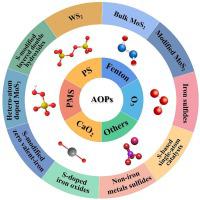当前位置:
X-MOL 学术
›
Coord. Chem. Rev.
›
论文详情
Our official English website, www.x-mol.net, welcomes your feedback! (Note: you will need to create a separate account there.)
Metal sulfides as emerging materials for advanced oxidation of wastewater: Recent developments, challenges, and prospects
Coordination Chemistry Reviews ( IF 20.6 ) Pub Date : 2024-03-20 , DOI: 10.1016/j.ccr.2024.215765 Jawad Ali , Sheng Guo , Yanan Chen , Ajmal Shahzad , Muhammad Wajid Ullah , Fengxi Chen
Coordination Chemistry Reviews ( IF 20.6 ) Pub Date : 2024-03-20 , DOI: 10.1016/j.ccr.2024.215765 Jawad Ali , Sheng Guo , Yanan Chen , Ajmal Shahzad , Muhammad Wajid Ullah , Fengxi Chen

|
Catalytic advanced oxidation processes (CAOPs) have received considerable attention for wastewater treatment. However, the insufficient stability of catalysts, coupled with the sluggish regeneration of active sites, poses a limitation to the sustained performance of CAOPs in practical applications over prolonged periods. To overcome these challenges, accelerating the M/M redox cycle (where M denotes transition metals and n denotes oxidation state) of catalysts during the treatment process emerges as a highly promising approach. This approach not only holds the potential to enhance efficiency but also offers a comprehensive solution for bolstering the stability of CAOPs. This comprehensive review summarizes the advancements in metal sulfide research, specifically emphasizing the evolving trend from homogeneous to heterogeneous reductants, with the objective of expediting the redox cycles of catalysts. The catalytic and co-catalytic roles of various metal sulfides, including MoS, WS, transition metals doped MoS/WS, iron sulfides, S-modified zero valent-iron, S-doped iron oxides, non-iron metals sulfides, S-modified layered double hydroxides, and S-based single-atom catalysts, in CAOPs, have been systematically summarized. These studies specifically concentrate on accelerating the M/M redox cycles of catalysts, thereby enhancing the overall efficiency, stability, and catalytic performance of both homogeneous and heterogeneous systems. Finally, the current challenges and future perspectives related to the applications of metal sulfide-based CAOPs for wastewater treatment were proposed to assist researchers in making efficient and stable heterogeneous Fenton/Fenton-like systems for industrial applications.
中文翻译:

金属硫化物作为废水高级氧化的新兴材料:最新进展、挑战和前景
催化高级氧化工艺(CAOP)在废水处理方面受到了广泛关注。然而,催化剂稳定性不足,加上活性位点再生缓慢,限制了CAOP在实际应用中的长期持续性能。为了克服这些挑战,在处理过程中加速催化剂的 M/M 氧化还原循环(其中 M 表示过渡金属,n 表示氧化态)是一种非常有前途的方法。这种方法不仅具有提高效率的潜力,而且还为增强 CAOP 的稳定性提供了全面的解决方案。这篇全面的综述总结了金属硫化物研究的进展,特别强调了从均相还原剂到非均相还原剂的演变趋势,目的是加快催化剂的氧化还原循环。各种金属硫化物的催化和助催化作用,包括MoS、WS、过渡金属掺杂MoS/WS、硫化铁、S-改性零价铁、S-掺杂铁氧化物、非铁金属硫化物、S-改性系统总结了CAOP中的层状双氢氧化物和S基单原子催化剂。这些研究特别集中于加速催化剂的 M/M 氧化还原循环,从而提高均相和非均相系统的整体效率、稳定性和催化性能。最后,提出了金属硫化物基CAOP在废水处理中应用的当前挑战和未来前景,以帮助研究人员为工业应用制造高效稳定的异质芬顿/类芬顿系统。
更新日期:2024-03-20
中文翻译:

金属硫化物作为废水高级氧化的新兴材料:最新进展、挑战和前景
催化高级氧化工艺(CAOP)在废水处理方面受到了广泛关注。然而,催化剂稳定性不足,加上活性位点再生缓慢,限制了CAOP在实际应用中的长期持续性能。为了克服这些挑战,在处理过程中加速催化剂的 M/M 氧化还原循环(其中 M 表示过渡金属,n 表示氧化态)是一种非常有前途的方法。这种方法不仅具有提高效率的潜力,而且还为增强 CAOP 的稳定性提供了全面的解决方案。这篇全面的综述总结了金属硫化物研究的进展,特别强调了从均相还原剂到非均相还原剂的演变趋势,目的是加快催化剂的氧化还原循环。各种金属硫化物的催化和助催化作用,包括MoS、WS、过渡金属掺杂MoS/WS、硫化铁、S-改性零价铁、S-掺杂铁氧化物、非铁金属硫化物、S-改性系统总结了CAOP中的层状双氢氧化物和S基单原子催化剂。这些研究特别集中于加速催化剂的 M/M 氧化还原循环,从而提高均相和非均相系统的整体效率、稳定性和催化性能。最后,提出了金属硫化物基CAOP在废水处理中应用的当前挑战和未来前景,以帮助研究人员为工业应用制造高效稳定的异质芬顿/类芬顿系统。



























 京公网安备 11010802027423号
京公网安备 11010802027423号